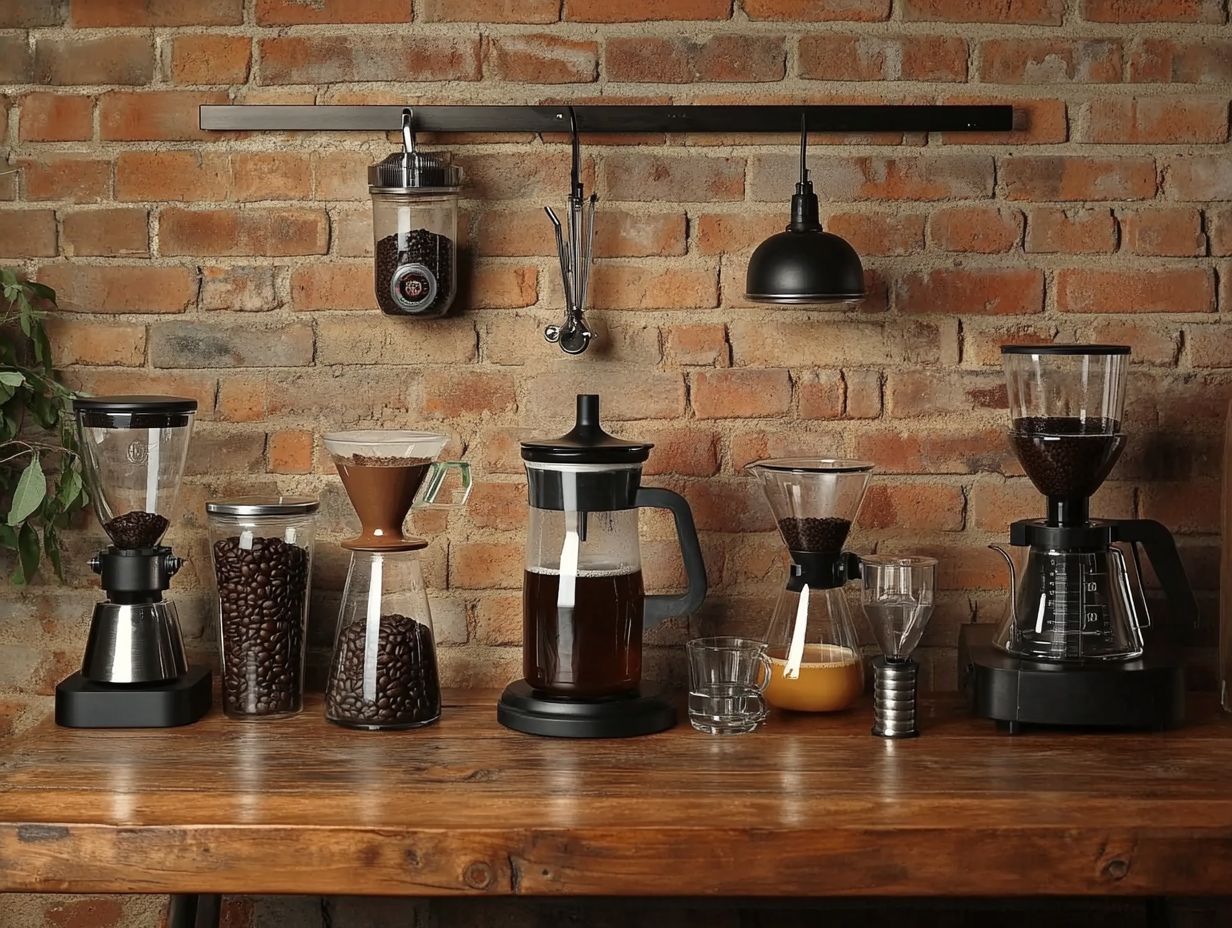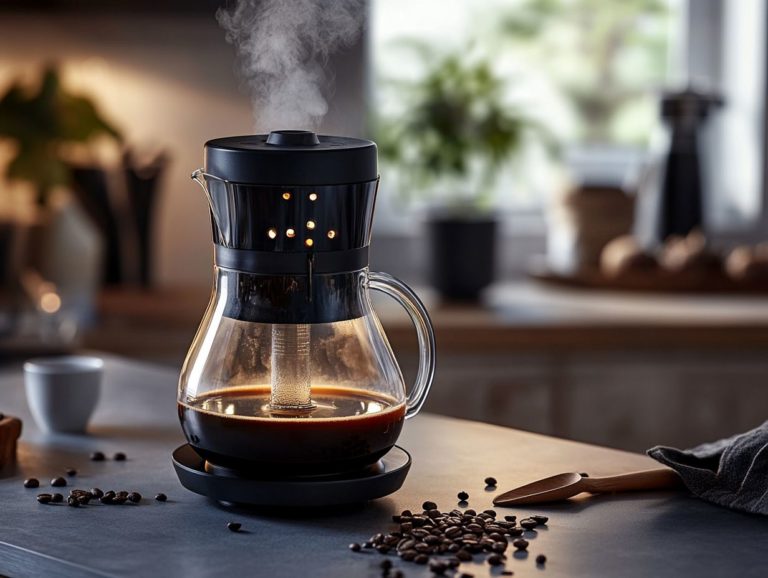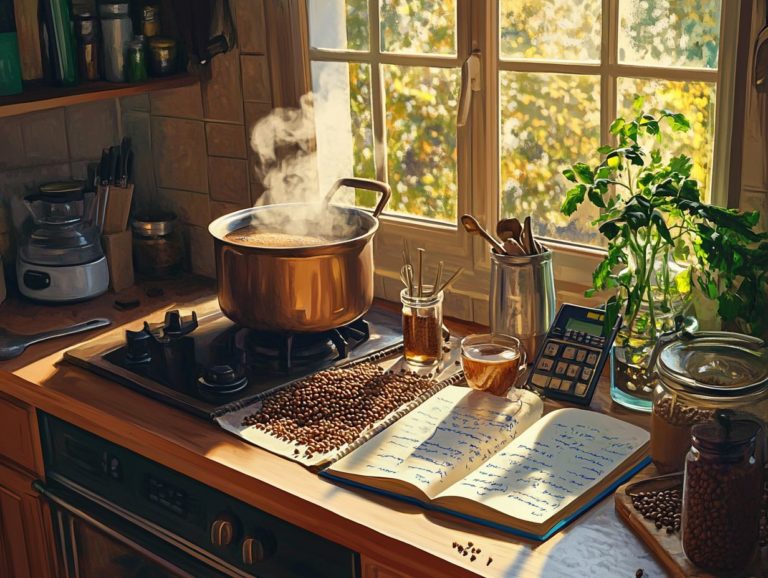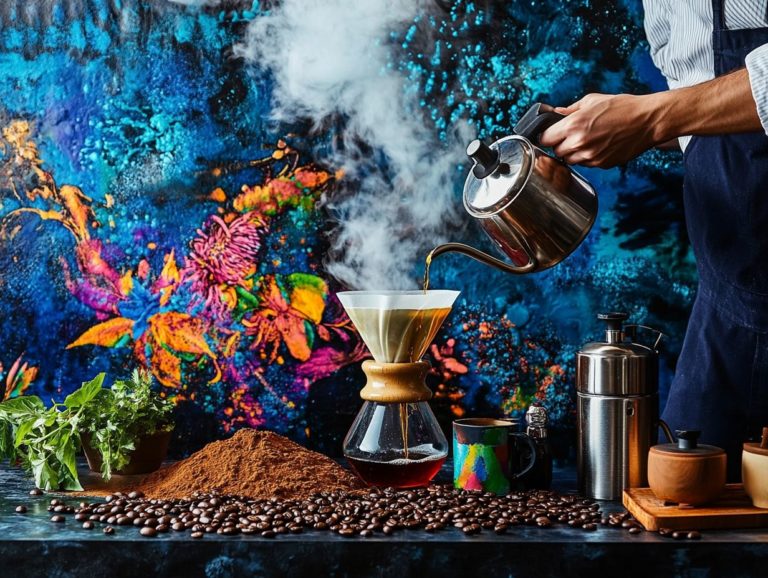Top 7 Brewing Methods for Coffee Lovers
For coffee enthusiasts like you, the brewing method can truly transform your experience, elevating your quest for that perfect cup of organic coffee.
With a multitude of techniques at your disposal, ranging from the classic drip coffee to the sophisticated art of espresso, including manual methods like pour-over and French press, each method offers its own unique flavor profile and subtle brewing nuances.
This guide delves into the top seven brewing methods, showcasing their taste, texture, and the advantages and disadvantages of each.
Whether you re a casual drinker or a dedicated connoisseur, you ll uncover which brewing style aligns perfectly with your taste preferences and lifestyle.
Contents
- Top Brewing Methods for Coffee Lovers
- 3. Pour Over
- 4. Cold Brew
- 5. AeroPress
- 6. Moka Pot
- 7. Espresso
- Which Brewing Method Is Right for You?
- Exploring the Differences in Taste and Texture between Each Brewing Method
- Making the Perfect Cup of Coffee with Each Method
- What Are the Pros and Cons of Each Brewing Method?
- How Can You Experiment with Different Brewing Methods at Home?
- Frequently Asked Questions
Key Takeaways:

- Expand your coffee knowledge and try new brewing methods like pour-over or cold brew for a unique and flavorful cup of coffee.
- Consider factors such as brewing time, taste, and equipment like a coffee maker or coffee cone when choosing a brewing method that fits your lifestyle and taste preferences.
- Each brewing method has its own distinct taste and texture, from the boldness of espresso to the smoothness of French press.
1. Drip Coffee
Drip coffee, often referred to as auto-drip coffee, stands out as one of the most favored brewing methods among coffee aficionados, celebrated for its convenience and ability to produce a clean, aromatic cup. This straightforward technique involves pouring hot water over coffee grounds, resulting in a consistent extraction that yields a balanced flavor profile.
Whether you re at home or savoring a brew in a local coffeehouse, drip coffee makers have become a cherished staple for those who appreciate their favorite beverage without the fuss of manual brewing methods.
To truly master the art of brewing drip coffee, you ll want to focus on several key factors: grind size, water temperature, and brewing time. Additionally, using high-quality coffee grounds and fresh coffee beans can elevate the flavor. These elements significantly influence the final taste of your cup. A medium grind typically strikes the right balance, preventing both over-extraction and under-extraction, while water temperatures ranging from 195 F to 205 F are ideal for unlocking the coffee s rich flavors. With a brewing time of around 5 to 7 minutes, you ll be rewarded with a cup that beautifully showcases the unique characteristics of the beans you ve chosen.
The remarkable flavor profiles achievable through this method cater to a wide array of preferences, making drip coffee a beloved choice for daily enjoyment, whether at home or at coffeehouses. Moreover, the rise of single-serve machines provides a convenient alternative, allowing you to brew your coffee exactly to your liking, ensuring a personalized experience every single time.
2. French Press
The French press is a cherished manual brewing method that delivers a rich, full-bodied cup of coffee, allowing you to fully savor the nuanced flavors and enticing aromas of freshly roasted beans.
This method invites you to immerse yourself in the tactile pleasure of brewing as you grind the coffee beans to a coarse consistency, reminiscent of sea salt. The use of fresh, high-quality beans significantly impacts the flavor. Attention to detail is essential; aim for the ideal water temperature between 195 F and 205 F to ensure that the delicate flavors are extracted without a hint of bitterness.
Once you add the hot water to the freshly ground coffee, let it steep for about four minutes to achieve optimal infusion. This brew method captures the full-bodied essence of the coffee beans. When compared to other brewing methods, such as pour-over, the French press captures more oils, resulting in a denser and more robust flavor profile that elevates your coffee experience to exquisite heights.
Top Brewing Methods for Coffee Lovers
3. Pour Over
Pour-over coffee is a meticulous brewing technique that invites you to embrace precision and control. It allows you to extract a full spectrum of flavors and aromas from your coffee grounds.
This method showcases the unique characteristics of different coffee beans, making it a go-to choice for coffee enthusiasts. At the heart of this process is the careful management of water temperature. Use water between 195 F and 205 F for the best flavor. The grind size is equally crucial a medium-fine grind typically delivers the best results, permitting water to flow through the grounds just right.
Your pouring technique can profoundly influence the outcome. A steady, circular motion ensures even saturation of the coffee, resulting in a beautifully balanced brew. Utilizing devices like the Chemex or Hario V60 elevates this experience. Their thoughtful design promotes effective filtration and allows more nuanced flavor profiles to emerge, transforming your coffee ritual into an art form.
4. Cold Brew
Cold brew coffee has quickly become a favorite for its smooth, mellow flavor and low acidity. It offers a refreshing alternative for those seeking a different coffee experience without the bitterness often linked to traditional hot brews.
This brewing method involves steeping coarsely ground coffee beans in cold water for an extended period, usually between 12 to 24 hours. This technique brings out the rich flavors and sweetness of the beans. Unlike traditional iced coffee, which is brewed hot and then cooled, cold brew boasts a uniquely distinct taste that accentuates the beans’ natural sweetness and intricate flavors.
The longer steeping time facilitates a gentle extraction of essential oils and sugars, yielding a rich, full-bodied coffee. You can enjoy it on its own or elevate it with milk and sweeteners. If you’re in search of a less acidic option that still delivers on flavor, you’ll love this brewing technique for its delightful flavor!
5. AeroPress

The AeroPress is an innovative coffee gadget that elevates your brewing game. It merges the finest elements of manual methods to deliver a clean and flavorful cup of coffee in a fraction of the time traditional techniques require.
To unlock the AeroPress s full potential, focus on a few key factors: grind size, water temperature, and extraction time. A finer grind, akin to table salt, works wonders for an espresso-like brew. Aim for a water temperature around 200 F for optimal extraction; this temperature allows rich flavors to flourish without bitterness.
Typically, a brew time of about 30 seconds to a minute strikes the perfect balance for a robust cup. The true beauty of the AeroPress lies in its versatility, effortlessly adapting to various brewing styles. Its compact design makes it a travel companion par excellence, ensuring that an exceptional coffee experience is always within your reach, whether you’re at home or on the go.
6. Moka Pot
The Moka pot stands as a timeless brewing method, crafting a rich and full-bodied coffee that rivals espresso. It s an absolute favorite for those who crave a bolder flavor without the intricacies of a traditional espresso machine.
This iconic device, often referred to as a stovetop coffee maker, operates by harnessing steam pressure to push boiling water through finely-ground coffee. This results in a concentrated brew that captivates the senses. The recommended coffee-to-water ratio usually hovers around one part coffee to two parts water, although you might find joy in experimenting to tailor it to your personal palate.
As the water in the bottom chamber heats up, it steams and rises, forcing the liquid through the coffee grounds above. This delivers a brew brimming with a robust flavor profile. Unlike other brewing methods such as drip coffee, the Moka pot bestows a thicker consistency and a more intense aroma, perfect for those seeking a profound coffee experience.
In Italian culture, the Moka pot transcends mere functionality; it symbolizes a treasured tradition. It often graces family gatherings and social occasions, solidifying its role as an enduring staple in countless Italian households.
7. Espresso
Espresso is not just coffee; it s a powerful and concentrated brewing method that extracts bold flavors and delivers a significant caffeine kick. It establishes itself as a cornerstone of coffee culture for both enthusiasts and casual drinkers.
Your journey begins with selecting the right grind size, which is crucial for achieving optimal extraction. A fine grind allows for efficient water flow, ensuring that all those delightful flavor compounds are fully extracted.
Pressure is equally important. Most espresso machines operate around 9 bars, forcing hot water through tightly packed coffee grounds. This meticulous process takes about 25-30 seconds, resulting in a rich shot adorned with a velvety crema on top.
If you’re in the mood for something creamier, drinks like lattes and cappuccinos provide a delightful balance between the boldness of espresso and the smoothness of steamed milk. They appeal to both those who crave intense flavors and those who prefer a milder coffee experience.
Using a vacuum or siphon coffee maker can also add an extra layer of complexity to your coffee.
Which Brewing Method Is Right for You?
Choosing the right brewing method for your coffee is crucial. It ensures that your beverage perfectly aligns with your taste preferences, whether you re after convenience, flavor complexity, or a brewing time that fits seamlessly into your lifestyle.
From the light and bright aromas of pour-over to the rich, full-bodied texture of French press, each method has its own unique merits. As you explore the world of coffee preparation, consider key factors.
Striking the right balance between rich flavor extraction and the brewing time you have on hand is essential. Whether you’re using a Chemex, Hario V60, or even experimenting with a Kalita, each tool can significantly influence your coffee’s final taste.
For example, a French press delivers a fuller-bodied brew that is perfect for those who love robust flavors. It requires about four minutes to steep.
On the other hand, drip coffee makers, including auto-drip models, offer incredible ease of use. They produce a consistent, milder flavor profile that s perfect for those busy mornings when convenience is key.
If you re in the mood for a quick yet powerful cup, espresso machines can deliver intensity in mere seconds. However, they come with a steeper learning curve and require mastering specific techniques.
By understanding these nuances, you can significantly elevate your coffee experience.
What Are the Key Factors to Consider When Choosing a Brewing Method?
When selecting a brewing method, several key factors come into play that you should consider. Your taste preferences, the convenience of the process, the time you can allocate to brewing, the beans you prefer, and the equipment at your disposal matter.
Each brewing method presents unique advantages tailored to various palates. For example, a French press offers a rich, full-bodied flavor. This delights those who savor robust coffee.
A pour-over technique allows you to exert greater control over brewing variables. This results in a cleaner cup that many connoisseurs hold dear.
The AeroPress provides a quick, manual brewing method that combines pressure and immersion for a unique taste experience.
Convenience is another significant factor to weigh. An espresso machine offers a quick and dynamic brewing experience, perfect for those hectic mornings. In contrast, cold brew presents a low-effort overnight steeping process for those who relish refreshing iced coffee.
For a more hands-on approach, the Moka pot delivers a rich, espresso-like brew on your stovetop.
If you’re just starting out, instant coffee or a simple drip coffee maker may be the ideal entry point. Conversely, seasoned aficionados might gravitate toward more intricate methods like siphon brewing or nitro coffee. These methods allow varying brewing times and techniques to profoundly influence the final flavor.
For cleanliness and clarity of flavor, many turn to Hario or Kalita pour-over systems.
Exploring the Differences in Taste and Texture between Each Brewing Method
Each coffee brewing method presents distinct differences in taste and texture. These differences profoundly impact your overall flavor experience and guide your preferences as a coffee drinker. From the brightness of a light roast to the richness of a dark roast, the type of coffee beans you choose plays a critical role.
The French press is a popular method. This technique allows coffee grounds to steep in hot water, resulting in a rich and robust flavor profile with a thicker, more textured mouthfeel. In contrast, the pour-over technique prioritizes clarity and precision. It often delivers a cleaner cup that highlights the coffee’s nuanced flavors and aromas.
The Hario V60 and Kalita Wave are popular choices among pour-over enthusiasts for their ease of use and consistent results.
Then there’s espresso. This method employs high-pressure brewing to extract oils and compounds rapidly, giving you a concentrated shot that masterfully balances intense richness with a velvety foam on top. With the right grind size and fresh, roasted beans, you can achieve a truly remarkable espresso experience.
Each brewing method not only alters how much flavor is extracted but also influences how you perceive various taste notes on your palate. Dive into the world of coffee brewing and explore a diverse range of flavor experiences that can elevate your coffee journey. Experiment with different brewing methods to discover your perfect cup, whether you’re brewing at home or sampling offerings from coffeehouses.
Making the Perfect Cup of Coffee with Each Method
To craft the perfect cup of coffee, you must master specific techniques associated with each brewing method. This includes selecting the right grind size, water temperature, and brewing time tailored to your chosen system. Understanding the role of coffee grounds and how much flavor is extracted can help you fine-tune your brew.
Each of these variables requires your attention based on the brewing method you employ, whether it s a French press, pour-over, or espresso. For example, a coarser grind is ideal for immersion brewing, while a fine grind is crucial for espresso to unlock the rich, bold flavors characteristic of that method. Always use fresh, high-quality coffee beans for the best results.
Water temperature plays a significant role in extraction rates. Aim for a range of 195 F to 205 F, which is optimal for most methods, though personal preferences may vary. You should also be mindful of brew time. Under-extraction can lead to a sour taste, while over-extraction might result in bitterness. Additionally, using the right filter can impact the final taste and aroma of your coffee.
By recognizing these parameters, you can fine-tune each cup and avoid common pitfalls that detract from your enjoyment. Simple adjustments, like tweaking the grind size or adjusting the brewing time, can dramatically enhance the flavor profile, ensuring you consistently enjoy your favorite brew. Consider exploring organic coffee options for a cleaner, sustainable choice.
What Are the Pros and Cons of Each Brewing Method?
Understanding the pros and cons of each brewing method allows you to make informed choices. This balance helps you consider convenience, flavor complexity, and the learning curve.
With many options available, from simple pour-over to sophisticated espresso machines, each method delivers a unique experience. The French press, for instance, offers a rich, full-bodied taste, but it takes time and effort to master.
An automatic drip maker prioritizes ease of use, yet it often falls short in delivering the depth of flavor that more hands-on methods can achieve. Some enthusiasts may even explore the complexity of vacuum or Moka pot brewing to heighten their experience.
These factors significantly shape your selection as a coffee enthusiast. If time is short, choose convenience. However, if you’re after intricate, nuanced flavors, you may dive into the art of various brewing techniques.
For example, trying out different methods like the Bodum French press or the classic Chemex can enhance your appreciation for the brewing process.
How Can You Experiment with Different Brewing Methods at Home?
Experimenting with different brewing methods at home presents a delightful opportunity to explore diverse flavors and tailor your coffee experience to your taste. Whether you’re using a coffee gadget like the Chemex or a traditional method such as the Moka Pot, each offers a unique brewing experience.
By trying various techniques like pour-over, French press, or AeroPress, you can uncover unique flavor profiles. This transforms each cup into a personal journey.
Begin by selecting a single-origin bean that piques your interest. Then, play around with parameters like grind size, water temperature, and brewing time to see how these adjustments influence flavor.
It’s wise to keep notes on the different methods you try and the resulting tastes. This practice deepens your understanding of what resonates with your palate. Documentation sparks creativity and serves as a handy reference for fine-tuning future brews.
Try a coffee cone for easy pour-over brewing at home.
Frequently Asked Questions
What are the top 7 brewing methods for coffee lovers?

- Pour over
- French press
- Cold brew
- AeroPress
- Chemex
- Siphon
- Drip coffee
What is pour over coffee and how is it brewed?
Pour over coffee involves pouring hot water over coffee grounds placed in a cone-shaped filter. The water slowly drips through the grounds, resulting in a clean and flavorful cup of coffee.
How does a French press work?
A French press uses a plunger and mesh filter to steep coffee grounds in hot water. After a few minutes, the plunger is pressed down to separate the grounds from the coffee, resulting in a rich and full-bodied cup.
What is cold brew coffee and why is it popular?
Cold brew coffee is made by steeping coffee grounds in cold water for an extended period. This method produces a smoother, less acidic coffee that is easier on the stomach.
What is the difference between AeroPress and Chemex?
AeroPress uses a pressurized method to extract coffee, resulting in a strong and concentrated cup. Chemex employs a pour-over method, resulting in a clean and crisp cup of coffee.
How does siphon coffee brewing work?
Siphon coffee brewing uses a vacuum brewer to mix hot water and coffee grounds. As the hot water passes through the grounds, it creates a vacuum effect that results in a smooth, flavorful cup of coffee.
This method is often found in specialty coffeehouses and provides a theatrical brewing experience that excites coffee lovers.
What makes drip coffee so popular?
Drip coffee is popular because it is a simple and convenient method that produces a consistent cup of coffee. It involves pouring hot water over coffee grounds in a filter, allowing it to drip into a carafe or mug below.






